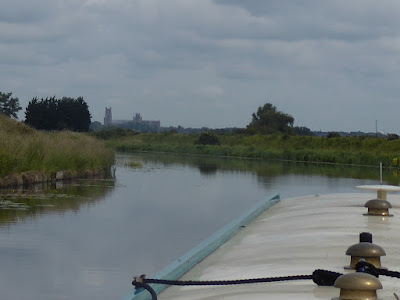We set off at 9:45. The weather was overcast and quite cold with a strong gusty wind which blew us off course from time to time and the river is still flowing strongly after the recent rains.The route took us through St Ives, beneath the 15th C bridge and on to the town's lock. Furtunately this was manned by a pair of volunteers who got us quickly through.
As we were leaving it started to rain and we were considering stopping early. However the rain died away and the weather became brighter and warmer. Below the lock the section of river was clearly high as moorings where we had previously had difficulty were well under water.
 |
| Flood water flowing therough Brownshill Staunch - the bottom gate is closed below water level! |
At Brownshill Staunch the Great Ouse normally descends onto a short section of tidal waterway. However this time we were surprised to see that the levels were the same and unusually high and water was flowing freely through the lock over the top of the lowered bottom guilotine gate. However it was not deep enough for the boat to pass so we still had to lower the top gate and raise the bottom gate to travel onwards.
Whilst we were working the lock another narrowboat turned up and the skipper came for a chat. He and his Mrs were Dutch, they had hired the boat for a week and this was the first lock they had ever operated and so I took them through the procedure. Perhaps this was not the best place for a beginner.
Beyond Brownshill Staunch at the village of Earith the river splits into a weir leading to the Old Bedford River, the main channel of the tidal New Bedford River and Hermitage Lock which takes one down below tide level onto the Old West River. The two Bedford rivers were constructed by Vermuyden in the 1600s when the Fens were drained to quickly remove flood water. The strength of flow as we turned away from the New Bedford towards the lock showed that they were still doing their job.
Hermitage Lock is manned as any failure here would flood half of East Anglia. The lock keeper wasnt completely sure whether the high water would prevent Densie passing beneath the road bridge that straddles the lock. I slowly drove the boat into the lock watching the top of the chimney fitting. At first there were perhaps 2 inches clear but eventually I had to stop as the chimney was scraping the underside of the bridge. Fortunately we were sufficiently far into the lock for the top gates to be closed and when the bottom paddles were raised we floated free.
Below Hermitage Lock the Old West River is completely different to the Great Ouse. It is shallow narrow and has very little current. After cruising for a further 3 miles we moored at Aldreth at 1:40.
11.25 miles, 3 locks, 4 hours cruising




























